Article Index
Mechanical BindingBy: Frank Shear
Reprinted from New England Printer & Publisher
Issue: December 1998
For products that must lie flat-as-a board, there is not substitute for quality
mechanical binding. Saddle stitching is a low cost alternative, but this binding method
isn’t appropriate for many projects. Layflat adhesive binding is a terrific option,
but even its pages don’t lie perfectly flat.
Mechanical binding is a great solution for many book projects. Imagine how poorly a
perfect bound calendar would look dangling from a wall. Not too appealing, right? For some
calendar styles, saddle stitching is a reasonable alternative, but stitches just
don’t have the same elegance as great looking mechanical binding elements. Properly
executed mechanical binding is truly a marriage of form and function.
Computers, high tech products, complicated equipment and many other products need
manuals that lie flat. Any computer user who has tried to read a perfect bound manual
while typing on a keyboard knows that perfect bound products are had to use in these
circumstances. Most perfect bound books will snap shut unless heavy pressure is applied,
which breaks the spine and causes pages to fall out. Mechanical binding is a time-tested
solution that solves this problem.
Mechanical Binding Options
There are four primary types of mechanical binding styles: Wire-O7 (Wire-O is a registered
trademark of James Burn International), plastic spiral, spiral wire and plastic comb. Each
has its own set of advantages and disadvantages.
Wire-O is generally considered the Cadillac of mechanical binding. It is an elegant,
durable and versatile binding style that has been popular for decades, yet never looks
dated. Bound pages open without a "step-up", which makes Wire-O an appropriate
choice for books with crossover images. Wire-O elements are available in a wide variety of
standard colors and is necessary, can even be specially ordered to match any PMS color, as
long as minimum quantities are satisfied. Since Wire-O can be highly automated, it is an
economical choice for long runs. Wire-O bound book blocks many be cased in either hard or
soft covers which makes beautiful, functional products. Although wire-O certainly is
strong, one downside is that if stepped on, Wire-O binding elements are permanently
damaged.
Plastic spiral is popular for use in products such as children’s books, high tech
manuals and cookbooks. Plastic spiral elements are very durable and spring back to their
original shape even after being crushed. For products to be used by children or placed on
fine furniture, plastic spiral doesn’t scratch and is generally considered to be
safer than wire-O. Like wire-O, plastic spiral elements are available in a wide variety of
colors and sizes. Although plastic spiral can be highly automated, as of now these
machines aren’t common, so long runs usually aren’t economical. Since plastic
spiral bound pages step-up when opened, avoid crossovers images whenever possible.
Spiral wire bound products have neither the elegance of Wire-O, nor the contemporary
appeal of plastic spiral. Although inexpensive, spiral wire-s popularity appears to be
declining. Unless a really thick gauge of wire is used, spiral wire binding isn’t as
strong as Wire-O because a single spiral wire coil is comprised of less wire than
Wire-O’s "double loop" design. And, like plastic spiral, spiral wire-s
pages step-up.
The fourth horseman of mechanical binding - plastic comb binding - is the most
different. Unlike the other three, plastic comb binding doesn’t open 360° , so it isn’t an attractive choice for books that need to be
held in one hand. In addition, plastic comb binding elements can be imprinted, but this is
quickly lost since the others can have printed reversible or fully concealed wrap-around
cover styles. Although plastic comb binding is useful for very thick books, many designers
think that plastic comb elements have a dated look, resulting in declining product
popularity.
Cover Styles
There are many cover style choices for mechanically bound products. Split back (two-piece)
covers are least expensive and most common cover style. When spine printing is necessary,
reversible and one-piece spine styles are good choices. Semi-concealed and cased-in styles
have an appearance that most looks like traditional books.
Perfectly formed Wire-O bound books have double-looped "teeth" that close
with a slight overbite holding pages firmly in place. Make sure that the seam of the wire
rests between the back cover and the last page of the book block. For plastic spiral
products, the crimped ends of the coil should never extend past the diameter of the coil
itself.
Production Planning
Since many mechanical binding projects involve a lot of job components, examine a
preflighted sample prior to the production run. Since good venders do this anyway, your
request shouldn’t affect your delivery date. Save time and money by working with your
bindery to ensure the right binding element is selected and that your complicated projects
can be automatically collated and trimmed.
Before having your bindery order Wire-O or plastic spiral binding elements, get a
bulking dummy made on the exact paper you will be using. Paper bulk varies between
different brands of paper and even between different lots of the same paper. If the
binding element is to tight, production will be slow and the pages will not easily turn.
If the binding element is too loose, the pages will be dwarfed and the whole book will
look ungainly. Changing sizes isn’t much of a problem for binderies that stock many
spools of wire in common colors as a courtesy to their customers. Be safe and ask your
bindery what their wire stocking policy is in advance.
If you deliver a pre-collated mechanical job to a bindery, it’s very important
that each page is the same size. If not, you risk incurring hand punching, which is
neither time nor cost effective. If your job has different page sizes, don’t
precollate it. For example, consider a mechanically bound book with alternating half- and
ful-size sheets. For a project of this type, a bindery would be able to punch all the
short sheets firs; the full-size ones second; and then automatically collate the job - as
long as it wasn’t pre-collated. Minimize your headaches by letting your bindery
professional guide the mechanical binding process from design through shipping.
When selecting your Wire-O binding supplier, make sure your choice has high-speed
inserting machines with both "jaw" style and "flat" close tools. For
some difficult projects, jaw-closing machines are preferable because they force the wire
to conform to the shape of the tool itself - yielding perfectly formed binding elements.
Flat-closing machines have very quick make readies and in many cases offer comparable
quality to jaw closing machines. For maximum flexibility, your bindery should have both
styles of machine.
Avoid Punching Problems
Punching into copy is an easily preventable, but all too common, problem.
Before you commit ink to paper, ask your bindery how much margin they need to clear the
punched holes for you project. In general, most 3:1 (three holes per linear inch) Wire-O
projects require a 3/8" spine margin. For 2:1 Wire-O books bulking over 1/2"
thick, allow at least 1/2" margin.
Punching tabbed pages is possible, but there must be empty space for
"pushers" on punching machines to reach a non-tabbed back edge of the paper.
Punching four-pagers is possible, but make sure that your binder OK’s the design
first. Punching Mylar or other acetate-reinforced sheets is fine, but if the substrate is
100% acetate, then your bindery should place a paper-based carry-sheet underneath each
lift to maintain cleanly punched holes. Punching other materials such as Pajco, laminated
paper, board and plastic is usually possible, but check with your bindery first.
For Wire-O books with odd-sized spines, make sure that your bindery properly centers
the punched holes along the spine edge because off-center books don’t look right.
However, odd-sized plastic spiral books may require the plastic spiral elements to be
slightly off center. For advice, ask your mechanical binding company about this situation
early in the design process.
Packing Issues
Packing is critical. It’s important that mechanically bound books are staggered (wire
left, wire right, wire left, etc.) so that the binding elements don’t rest on other
books, creating unwanted indentations and marking. Carton selection is very important. For
example, standard boxes that fit normal 8 1/2" x 11" products won’t perform
well for books needing staggered packing. Cramming books into wrong-sized boxes is always
a recipe for disaster, as is packing books too loosely. If uncoated tin wire is used, then
marking problems are likely to occur. For books that are identified as likely candidates
for transit marking, slip sheeting, shrinkwrapping or foam packing should be used.
Mechanical binding is a rapidly growing segment of the book binding industry because it
offers a world class solution for products that must lay flat. Hop on the mechanical
binding bandwagon, plan your jobs wisely and delight your customer. After all, isn’t
this what we are really after?
TWO PIECE
Most common cover style. Separate front & back covers. Opens
easily back-to-back. |
REVERSIBLE
The partially hidden Wire-O is exposed on the front cover and/or back
cover. Flat spine allows for easy identification. |
ONE PIECE (Spine Bound)
Allows for an expandable inside cover where a large spread image is
important. The binding is hidden and the spine is flat. |
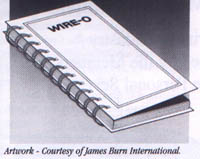 |
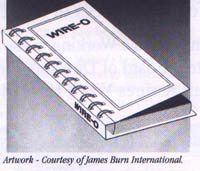 |
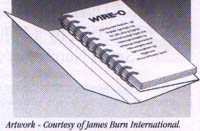 |
WRAP-AROUND
A popular, attractive one-piece wrap-around cover with a permanent
look. |
CASED IN
The attractive appearance of a hard case book with all the advantages
of Wire-O binding. recommended for reference or library books. |
EASEL
The ultimate presentation. A free-standing triangular cover. Pages
flip easily. |
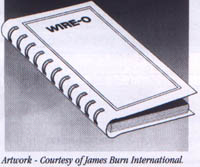 |
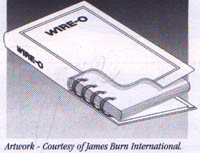 |
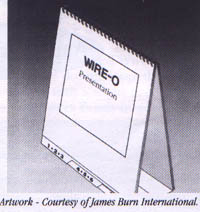 |
Article Index